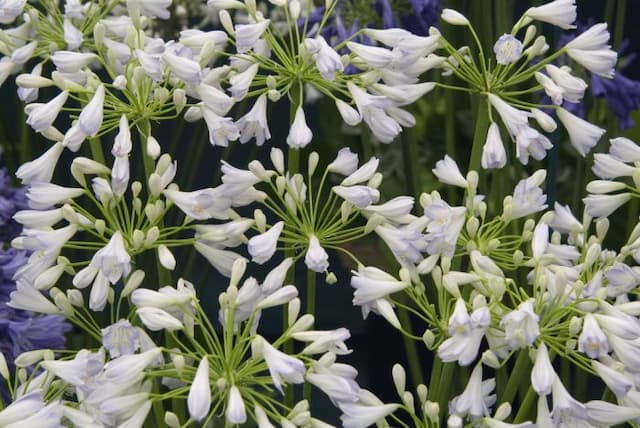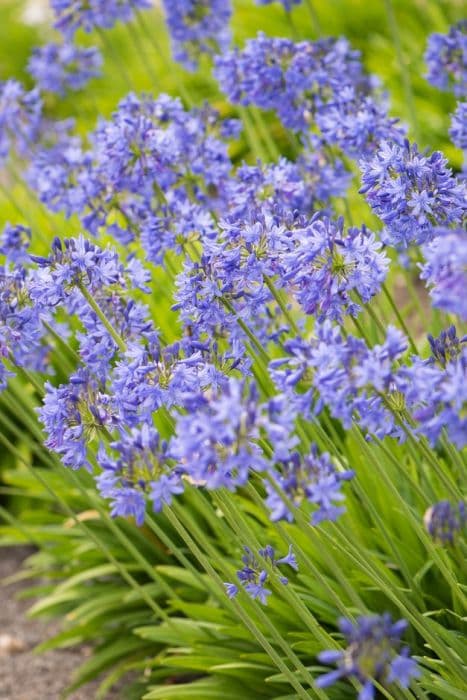Bell Agapanthus Agapanthus campanulatus var. albidus

ABOUT
Commonly known as the White Bell Agapanthus, this plant is characterized by its striking appearance. The most prominent feature is its beautiful, bell-shaped flowers that are a pure, clean white color. These blooms are typically clustered at the end of a long, erect flower stalk, rising above the foliage like an elegant bouquet. The flowers are frequented by various pollinators and can add a touch of brightness to any garden. The foliage of the White Bell Agapanthus is also quite notable. It consists of strap-like leaves that are lush green, emanating from the base of the plant in a dense cluster. The leaves have a graceful arch, giving the plant a soft, mounded form. This lush greenery provides a perfect backdrop for the spectacular flowers and contributes to the plant's overall ornamental appeal. The White Bell Agapanthus can be included in a garden to provide color contrast, particularly due to its white flowers that can complement a variety of other plant colors. Its elegant form makes it an excellent choice for borders, as an accent plant, or when planted en masse for a dramatic effect. Moreover, the plant's ability to thrive in various conditions makes it a popular choice for gardeners looking for plants that require moderate maintenance while still offering a visually charming display.
About this plant
 Names
NamesFamily
Amaryllidaceae
Synonyms
White African Lily, White Lily of the Nile
Common names
Agapanthus campanulatus var. albidus.
 Toxicity
ToxicityTo humans
The African Lily, which is a common name for Agapanthus campanulatus var. albidus, is considered to have a low level of toxicity to humans. If ingested, parts of the plant can cause gastrointestinal discomfort such as nausea, vomiting, and diarrhea. Skin contact with the sap may sometimes lead to irritation or dermatitis in sensitive individuals. It is generally advised to avoid consuming any part of this plant to prevent these adverse effects.
To pets
The African Lily is toxic to pets such as cats and dogs. Ingestion of any part of the plant, particularly the leaves or rhizomes, can cause vomiting, diarrhea, lethargy, and drooling. In severe cases, ingesting large quantities could potentially lead to more serious symptoms such as tremors or an irregular heartbeat. It is important to keep the African Lily out of reach of pets to prevent poisoning.
 Characteristics
CharacteristicsLife cycle
Perennials
Foliage type
Evergreen
Color of leaves
Green
Flower color
White
Height
2 feet (60 cm)
Spread
2 feet (60 cm)
Plant type
Bulb
Hardiness zones
8
Native area
South Africa
Benefits
 General Benefits
General Benefits- Ornamental Value: Agapanthus campanulatus var. albidus, commonly known as the Bell Agapanthus, is valued for its striking blue or white bell-shaped flowers that add aesthetic appeal to gardens and landscapes.
- Drought Resistance: The plant is drought-tolerant, making it suitable for xeriscaping and water-wise gardening, which is especially beneficial in areas with water restrictions.
- Low Maintenance: Bell Agapanthus requires minimal care once established, which makes it an ideal choice for busy gardeners or those new to gardening.
- Attracts Pollinators: The blooms of the Bell Agapanthus attract bees, butterflies, and other pollinators, supporting biodiversity and helping to maintain healthy ecosystems.
- Soil Erosion Control: The thick roots of the Bell Agapanthus help to stabilize soil and reduce erosion, particularly in sloped areas of the garden.
- Long Blooming Period: The plant has a long flowering season, which ensures that gardens have a continuous display of color and interest for an extended period.
- Versatility: Bell Agapanthus can be used in a variety of garden settings, including borders, containers, and as a focal point in flower beds.
 Medical Properties
Medical PropertiesThis plant is not used for medical purposes.
 Air-purifying Qualities
Air-purifying QualitiesThis plant is not specifically known for air purifying qualities.
 Other Uses
Other Uses- Agapanthus can be used in the production of blue dye for textiles, utilizing the blue pigment contained within the flowers.
- The strong leaves of the Agapanthus are traditionally used for weaving baskets and mats in some African cultures.
- In floral arrangements, Agapanthus provides a striking architectural element due to its tall stalks and spherical blooms.
- Agapanthus can be planted to stabilize soil in areas prone to erosion thanks to its robust root system.
- The plant's sap has been used in certain cultures as a glue for small-scale repairs.
- Garden designers often utilize Agapanthus for its ability to attract pollinators such as bees and butterflies to the garden.
- The dried seed heads of Agapanthus make attractive additions to dry flower arrangements and wreaths.
- As a theme plant, Agapanthus is popular for 'blue' gardens, where all plants flower in shades of blue.
- Agapanthus has been used in educational settings to study plant structure and pollination mechanisms.
- The plant is also used for ornamental purposes in ponds and water features, as it can tolerate damp conditions.
Interesting Facts
 Feng Shui
Feng ShuiThe Agapanthus, commonly known as Lily of the Nile, is not specifically mentioned in traditional Feng Shui practice.
 Zodiac Sign Compitability
Zodiac Sign CompitabilityThe Lily of the Nile is not used in astrology practice.
 Plant Symbolism
Plant Symbolism- Love Letters: The genus name Agapanthus is derived from the Greek words 'agape' (love) and 'anthos' (flower), suggesting the plant symbolizes a message of love.
- Beauty: With its striking white blooms, Agapanthus campanulatus var. albidus is often associated with beauty and elegance, echoing the refined and attractive nature of the flowers.
- Endurance: This plant is known for its hardiness and ability to thrive in harsh conditions, symbolizing resilience and survival.
- Freedom: The open bell-shape of the blossoms can represent freedom and liberation, often inspiring a sense of release from constraints.
 Water
WaterThe Agapanthus, commonly known as the African Lily or Lily of the Nile, prefers regular watering to keep the soil evenly moist but not soggy. During active growth in spring and summer, water approximately once a week with about one gallon of water per plant, ensuring you are watering deeply to encourage root development. Reduce watering frequency to every two to three weeks during the dormant winter period, providing just enough to prevent the soil from completely drying out. Adjust the watering schedule based on rainfall, and always check the soil moisture before watering to avoid overwatering.
 Light
LightAfrican Lilies thrive in full sun to partial shade, with at least six hours of sunlight per day being ideal to encourage abundant flowering. The best spot for planting is one where they receive morning sunlight and some protection from the intense afternoon sun, especially in hotter climates. Avoid placing them in deep shade, as this will significantly reduce blooming and can lead to weaker plants.
 Temperature
TemperatureThe African Lily is hardy and can tolerate temperatures down to about 20°F, though it prefers to grow in warmer conditions. The ideal temperature range for the African Lily is between 60°F and 75°F. It can survive short periods of colder weather but should be protected from prolonged freezes, so in climates with cold winters, consider mulching or bringing container plants indoors.
 Pruning
PruningPrune the African Lily to remove spent flowers and seed pods to encourage further blooming and to maintain plant appearance. Additionally, trim away any dead or damaged foliage as needed. The best time for pruning is immediately after the bloom period has ceased, which is typically in late summer or early fall.
 Cleaning
CleaningAs needed
 Soil
SoilThe ideal soil mix for the Agapanthus, commonly known as the African Lily, should be rich, well-draining, and slightly acidic to neutral, with a pH between 6.0 and 7.0. A blend of two parts loam, one part perlite or coarse sand, and one part well-rotted compost or peat moss will ensure proper drainage and fertility.
 Repotting
RepottingAfrican Lilies should be repotted every 2 to 3 years as they outgrow their containers. It's best to do this in the spring before the growing season begins to minimize stress on the plants.
 Humidity & Misting
Humidity & MistingAfrican Lilies prefer moderate humidity levels, but as outdoor plants, they are generally adaptable to the natural ambient humidity. Indoors, the typical room humidity should be sufficient, with no special requirements.
 Suitable locations
Suitable locationsIndoor
Place African Lily in bright, indirect light and maintain a consistent watering schedule.
Outdoor
Plant African Lily in full sun to partial shade in well-draining soil.
Hardiness zone
7-11 USDA
 Life cycle
Life cycleAgapanthus campanulatus var. albidus, commonly known as the white bell agapanthus, begins its life as a seed that, once sown, germinates in the presence of adequate warmth and moisture. The seedling emerges with a set of initial leaves and will eventually develop a fleshy root system and produce strap-like foliage. The plant grows vegetatively for several years before reaching maturity, where it forms a cluster of leaves at the base and stores energy in its rhizomes. Once mature, usually after several years, it produces tall flowering stalks with clusters of bell-shaped white flowers during the summer months. After pollination, typically by insects, the flowers develop into seed capsules containing multiple seeds, which when mature, are released into the environment to begin a new cycle. In colder climates, the plant may die back to the rhizome in winter, but will regrow and continue its cycle with the onset of warmer spring temperatures.
 Propogation
PropogationPropogation time
Spring to Summer
Propogation: The best time to propagate Agapanthus, commonly known as Lily of the Nile, is during the spring or early summer when the plant comes out of dormancy and begins active growth. The most popular method for propagating Agapanthus campanulatus var. albidus is by division. This involves carefully lifting the plant from the ground, using a sharp spade or knife to separate the clump into sections, each with a portion of the root system and several shoots. These divisions can then be immediately replanted into a well-draining soil mix at the same depth they were originally growing. It's important to water the new divisions well to help establish them, providing an inch (about 2.5 centimeters) of water per week if there isn't sufficient rainfall.









